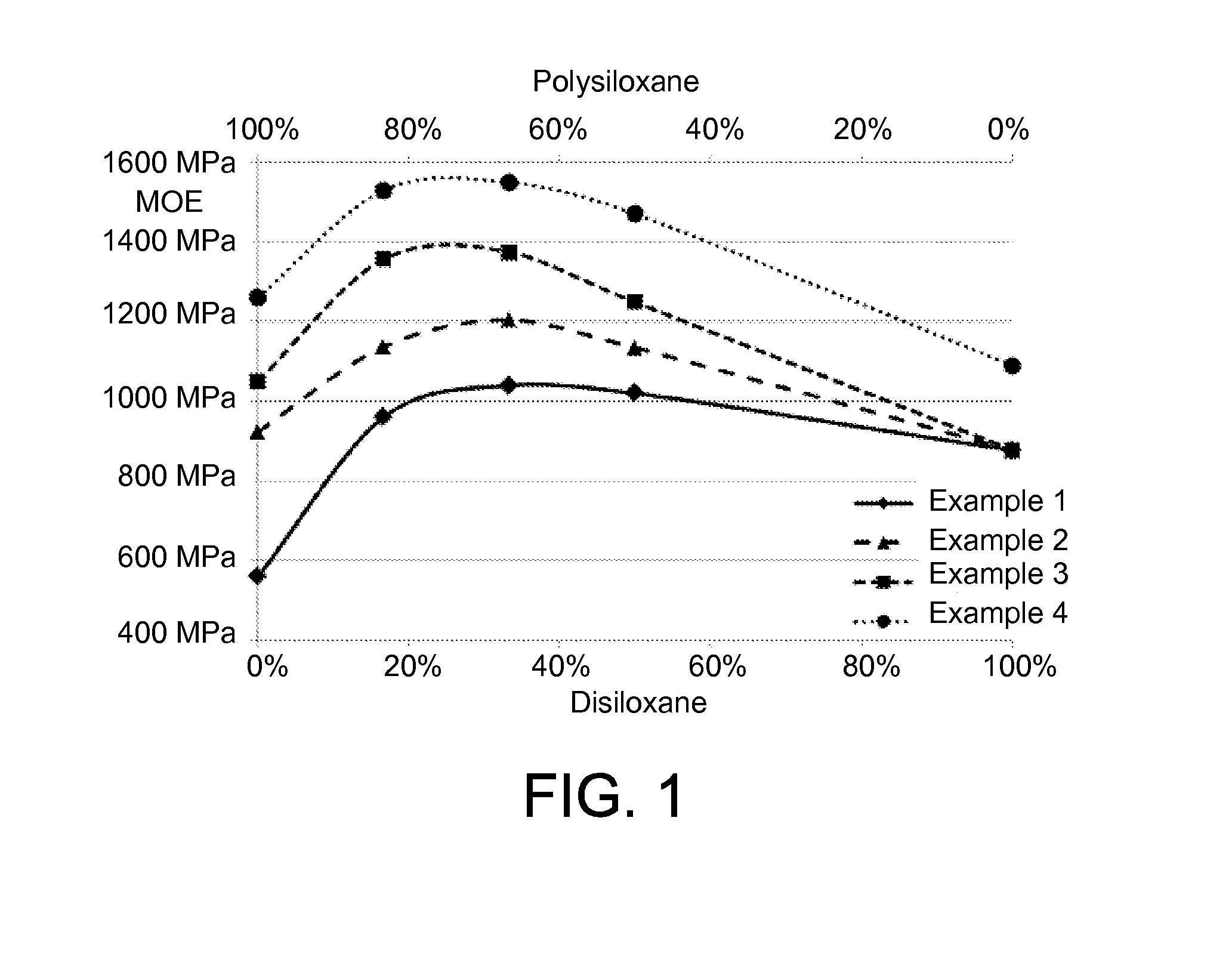Use of free radically curable compositions in additive manufacturing methods
a composition and additive manufacturing technology, applied in dental prosthetics, dental preparations, impression caps, etc., can solve the problems of uncured uncured uncured sites, unsatisfactory final hardness and strength of parts, and document does not contain inventive compositions containing polysiloxanes
- Summary
- Abstract
- Description
- Claims
- Application Information
AI Technical Summary
Benefits of technology
Problems solved by technology
Method used
Image
Examples
examples
[0218]Substances used:[0219]Polysiloxane I: Methacryl-POSS (MA0735, Hybrid Plastics Inc.)[0220]Polysiloxane II: condensation product of 3-methacryloyloxypropyldimethoxy-methylsilane[0221]Polysiloxane III: condensation product of 3-methacryloyloxypropyltrimethoxy-silane[0222]Polysiloxane IV: condensation product of 3-[(2-hydroxy-3-methacryloyloxy)propoxy]propyldimethoxymethylsilane[0223]Disiloxane I: 1,3-bis(3-methacryloyloxy-propyl)tetramethyldisiloxane[0224]Disiloxane II: 1,3-bis[3-[(2-hydroxy-3-meth-acryloyloxy)propoxy]propyl]tetra-methyldisiloxane[0225]Bis-GMA: 2,2-bis[4-(2-hydroxy-3-methacryloyloxypropoxy)phenyl]propane[0226]UDMA: 7,7,9-trimethyl-4,13-dioxo-5,12-diazahexadecane 1,16-dioxydimethacrylate[0227]DDM: dodecanedioldimethacrylate[0228]CQ: DL-camphorquinone[0229]DABE: ethyl 4-dimethylaminobenzoate[0230]TPO: 2,4,6-trimethylbenzoyldiphenyl-phosphineoxide[0231]Tinuvin 571: 2-(2H-benzotriazol-2-yl)-6-dodecyl-4-methylphenol[0232]BHT: 2,6-di(tert-butyl)hydroxytoluene
Synthesis ...
examples 1-4
[0243]CQ and DABE were dissolved in the respective monomers (polysiloxane and disiloxane). The solutions were freed of air at vacuum −0.9 bar. The flexural strength (FS) of the individual resins was determined, and these measurements were used to calculate the modulus of elasticity (MOE).
[0244]Surprisingly, a higher modulus of elasticity is found for the mixtures of polysiloxane and disiloxane than for the two respective individual components (FIG. 1). The maximum for the modulus of elasticity was found at a ratio of polysiloxane to disiloxane of about 2:1. A higher modulus of elasticity means that the cured material can offer greater resistance to deformation and hence can better withstand the constant chewing stress.
example 1
[0245]
TABLE 1Composition and properties of poly- / disiloxane resins 11-A1-B1-C1-D1-EPoly-99.2582.7166.1749.6250.00siloxane IDisiloxane I0.0016.5433.0849.62599.25CQ0.300.300.300.300.30DABE0.450.450.450.450.45FS 9.9 MPa20.8 MPa 25.2 MPa 28.2 MPa36.3 MPaMOE560 MPa 960 MPa1040 MPa1020 MPa 880 MPa
PUM
| Property | Measurement | Unit |
|---|---|---|
| particle size | aaaaa | aaaaa |
| particle size | aaaaa | aaaaa |
| particle size | aaaaa | aaaaa |
Abstract
Description
Claims
Application Information
 Login to View More
Login to View More - R&D
- Intellectual Property
- Life Sciences
- Materials
- Tech Scout
- Unparalleled Data Quality
- Higher Quality Content
- 60% Fewer Hallucinations
Browse by: Latest US Patents, China's latest patents, Technical Efficacy Thesaurus, Application Domain, Technology Topic, Popular Technical Reports.
© 2025 PatSnap. All rights reserved.Legal|Privacy policy|Modern Slavery Act Transparency Statement|Sitemap|About US| Contact US: help@patsnap.com



